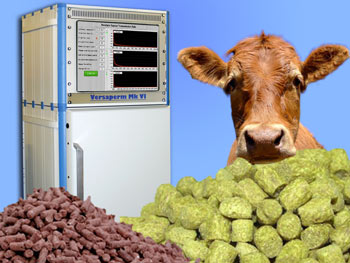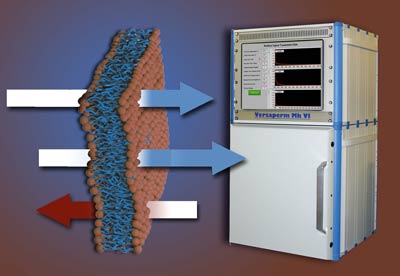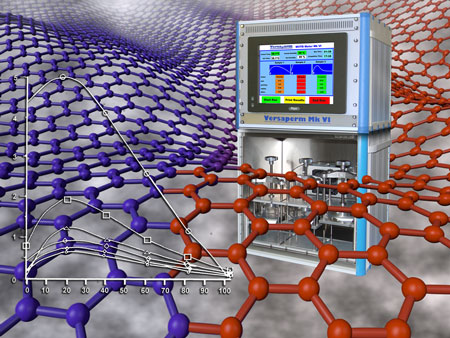

According to the Global Methane Initiative the second most important agricultural sources of methane emissions, and the one that offers the most viable, near-term opportunities for methane recovery and utilization is livestock waste management.
 This, together with a completely separate agricultural problem actually have a common part to their solution. And methane permeability is the link. Both feeds and animal waste storage / biogas generation sites need to use methane barriers - materials such as PVC have been used in the past. However, modern laminating techniques have produced new materials, which are far better methane barriers, but react differently to other gases and this may, or may not render them fit for purpose.
This, together with a completely separate agricultural problem actually have a common part to their solution. And methane permeability is the link. Both feeds and animal waste storage / biogas generation sites need to use methane barriers - materials such as PVC have been used in the past. However, modern laminating techniques have produced new materials, which are far better methane barriers, but react differently to other gases and this may, or may not render them fit for purpose.
The only solution is to test for both methane permeability and the permeability of other relevant gases – and that's where we come in. Both our single and multi-chamber instruments can be used to measure the vapour permeability of both waste and feed storage / packaging containers for methane.
The equipment measures permeability, quickly, accurately and with minimal operator training. Yet it is typically accurate to a few parts per million (ppm) or better. The system is fast – giving readings in as little as 30 minutes for some materials – which is much faster than conventional gravimetric measurements, which take days or even weeks.
The new instruments can cope with several samples at a time. However, for companies who test too few samples to make the purchase of equipment viable, we also offer a fast turnaround laboratory testing service
There follows a summary or some some of the important materials:-
 Polyvinylidene Chloride (PVdC): Used for MAP as a gas-barrier coating, often sandwiched between other materials. It has outstanding barrier properties with low permeability to water vapour and gases.
Polyvinylidene Chloride (PVdC): Used for MAP as a gas-barrier coating, often sandwiched between other materials. It has outstanding barrier properties with low permeability to water vapour and gases.
Polystyrene: A clear thermoplastic with a high tensile strength. It is brittle and a poor barrier to moisture vapour and gases.
Polypropylene (PP) and Oriented Polypropylene (OPP): Gives a high water vapour and gas barrier and has excellent grease resistance.
PET: High clarity that forms and thermoforms well.
High-impact Polystyrene: Opaque, thermoformable, and a moderately low gas-barrier.
High Density Polyethylene: with its higher softening point (than LDPE) it provides a physical barrier buts not suitable as a thermoformable sealant layer, clarity is poor.
Inomers: Are similar to polyethylene but have a high tack and can seal through a level of surface contamination.
 Ethylene Vinyl Alcohol (EVOH): A moisture sensitive, very high gas-barrier material, again often sandwiched.
Ethylene Vinyl Alcohol (EVOH): A moisture sensitive, very high gas-barrier material, again often sandwiched.
Ethylene Vinyl Alcohol (EVOH): A moisture sensitive, very high gas-barrier material, again often sandwiched.
Ethylene Vinyl Acetate, has superior sealing qualities and blended polyethylene can make a strong peelable seal.
Co-extruded Oriented Polypropylene (COPP): Is a good moisture barrier, gas barrier properties can be improved by coating it with PVdC. It can be used when gas flow is desired for MAP (Modified Atmosphere Packaging).
Ethylene Vinyl Acetate (EVA): Has high flexibility, and high permeability to water vapour and gases with excellent oil and grease resistance.
Low Density Polyethylene: An extremely versatile material with low water vapour permeability but high gas permeability.
Linear Low-Density Polyethylene (LLDPE): This has greater impact and puncture strength, tear resistance, elongation and resistance to cracking. It is commonly used for MAP.
Using the most appropriate materials can dramatically extend the life of snacks and preserve flavour, texture quality. However it depends not just the materials you use, but on the way you make the seals – which can vary even on the same equipment on a daily basis. The best solution is to test the materials, the packaging and the finished products.
For Global Methane Initiative click
For U.S. Environmental Protection Agency's AgSTAR Program for the recovery and use of Methane click
For a press release click